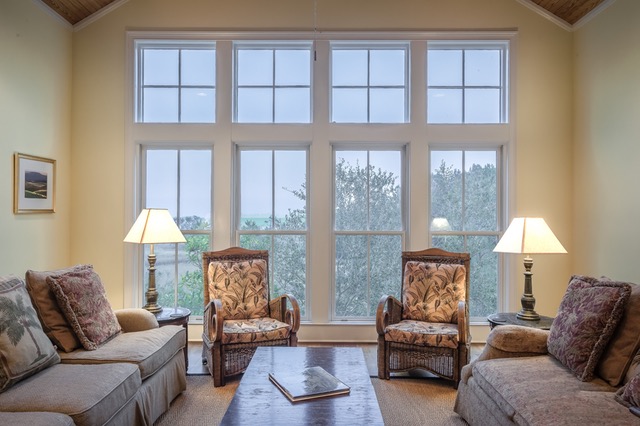
Some consider pollution to be a problem that only occurs outside because of popular topics such as acid rain, smog, ozone and noxious hazes. In reality, it is common for the air inside homes and businesses to be more polluted than the air outside, according to the U.S. Environmental Protection Agency. Because most individuals spend 90 percent of their lives inside, indoor air quality has a significant impact on overall health. Fortunately, improving the air quality in your home or workplace is easy with steps that are simple to integrate into your maintenance routine.
Download our quick reference checklist to ensure you have high-quality indoor air: [download id=”3897″]
Factors that Affect Indoor Air Quality 
- Dust
- Pollen
- Dust mites
- Pet dander
- Lead paint in older buildings
- Mold
- Volatile organic compounds found in many products, such as new mattresses, carpets, plug-in air fresheners, deodorizers, solvents, adhesives, cleaning chemicals and furniture
- Smoke
- Carbon monoxide
- Nitrogen dioxide
- Asbestos in older buildings
- Radon
- Phthalates found in fragranced products
- Poor ventilation
- Vehicle exhaust
- Odors from trash cans
- Pesticides
The EPA classifies indoor air pollutants into three categories: combustion pollutants, volatile organic compounds, and allergy triggers. Combustion pollutants are particles or gases that come from burning different types of fuel, such as gas, oil or wood. Volatile organic compounds (VOCs), are gases that some liquid and solid materials release. Allergy triggers include dust, pollen, pet dander, secondhand smoke, mold, and dust mites.
How to Improve Indoor Air Quality
1. Monitor carbon monoxide levels.
Carbon monoxide (CO) is a harmful odorless gas often associated with gas stovetops, water heaters and HVAC equipment. It can also come from fireplaces, engine exhaust, grills, generators, lanterns and candles. When the gas accumulates in a space, it displaces oxygen in the blood.
To prevent CO from accumulating in your home:
- Hire a licensed professional to maintain and inspect the gas appliances in your home, such as a gas fireplace or furnace
- Warming up your car in the driveway instead of the garage
- Only use generators, grills and large lanterns outside
If you have gas appliances, install CO on every level of your home and outside bedroom doors. Test the detector once a week. Your local fire department can provide recommendations regarding the best detector to use. While a CO detector will not improve indoor air quality, it will alert you to danger.
2. Assess the chemical use in your home.
Everyday household products often contain volatile organic compounds, such as cleaners, beauty products, dry-cleaned clothes, building materials, air fresheners and paint. Common VOCs include perchloroethylene, ethylene glycol, ammonia, chlorine, methylene chloride, formaldehyde, acetone and benzene.
Reduce your exposure to VOCs by:
- Avoiding aerosol sprays, such as spray paint, deodorant, air fresheners or hairspray
- Purchasing cleaning products and air fresheners that use natural ingredients, such as essential oils, lemon, vinegar, baking soda or borax
- Purchasing fragrance-free or naturally scented soaps and detergents
- Use candles made of soy or beeswax instead of petroleum-based wax
- Using products with VOCs outdoors or in well ventilated areas
- Use houseplants known to filter the air, such as Boston ferns, spider plants, peace lilies, red-edged dracaena and chrysanthemums
3. Reduce the smoke emitted from your fireplace and stove.
Similar to secondhand smoke, the smoke produced by fireplaces and stoves is harmful. Regular maintenance, as well as annual professional cleanings and inspections, go a long way toward ensuring that your fireplace works safely. Other ways to reduce smoke in your home include:
- Opening the damper when starting a fire
- Knowing how the pressure in your home affects the fireplace’s performance; if your home has negative pressure, for example, you may need to open a nearby window when starting a fire so the fireplace drafts smoke up the chimney instead of into your home
- Building smaller fires toward the rear of the firebox
- Installing folding glass doors on open fireplaces
- Installing a chimney cap if one is not present
4. Improve ventilation.
Poor ventilation can contribute to ailments related to poor indoor air quality. Improving the airflow in your home and creating a healthier environment is as simple as:
- Opening a window
- Hire a licensed professional to clean and inspect the ducts in your home
- Running the exhaust fan in the kitchen or bathroom when you cook, clean and bathe
- Changing the filters in your HVAC equipment monthly
If someone in your home is sensitive to outdoor allergens, consider installing an air purification or filtration system that does not produce ozone.
Improving indoor air quality in your home or business is not a task that you have to face on your own. AAA Heating and Cooling offers a variety of solutions that help make this task simpler, including duct cleaning, air purification and filtration systems, humidity control systems, ventilation systems, and indoor air monitoring. Talk to an air quality specialist today to learn more about promoting a healthy environment in your home that does not sacrifice comfort.